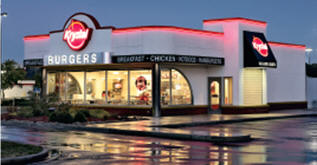 Krystal restaurants don't just
inspire customer loyalty - they create true devotees. In the southeast
U.S., where the majority of Krystal restaurants are located, it's said
that practically everyone has "a Krystal story." Serving customers for
more than 74 years, The Krystal Company has grown from a single
restaurant into a multi-million dollar restaurant chain. Customers are
known to camp outside a new Krystal restaurant for days before its
opening. Others choose to drive, rather than fly, on interstate trips
just to stop at some of the 418-plus Krystal outlets along the way.
Krystal restaurants don't just
inspire customer loyalty - they create true devotees. In the southeast
U.S., where the majority of Krystal restaurants are located, it's said
that practically everyone has "a Krystal story." Serving customers for
more than 74 years, The Krystal Company has grown from a single
restaurant into a multi-million dollar restaurant chain. Customers are
known to camp outside a new Krystal restaurant for days before its
opening. Others choose to drive, rather than fly, on interstate trips
just to stop at some of the 418-plus Krystal outlets along the way.However, passionate fandom is only part of Krystal's growth recipe. Another special ingredient is location intelligence. MapInfo has provided the company with a Sales Forecasting System for projecting the performance of any Krystal location - existing or new, franchised or company-owned.
"With MapInfo's help," says Gary Greve, Krystal's real estate director, "we've greatly enhanced the science and art of site selection for our brand. This is absolutely crucial to our profitable future."
Krystal applies the Sales Forecasting System for macro and micro level analyses. Greve explains, "We can get the proverbial view from 30,000 feet on a new market, and we can also drill down for tight comparisons of specific sites. This not only helps us plot our expansion, it can also provide the back-up data our franchisees need to secure their funding."
Greve cites this recent example of the Sales Forecasting System at work. "A little over a year ago, one of our restaurants in Knoxville unfortunately burned to the ground. Before committing to rebuild it, we re-examined our site deployment in the immediate area. In this case, there was a Krystal restaurant a couple of miles to the east of the site of the fire and another, a couple of miles to the west."
Greve continues, "Krystal was founded in 1932, and many of our restaurants have been where they are for a long time. Not all of the older stores are in optimal locations. Using the sales forecasting system, we determined our best course of action in Knoxville was to rebuild the restaurant that had burned down and close one of the other nearby stores." Per Greve, "The new store was projected to generate nearly the same total revenue as the previous and closed units combined. This improved the economies of scale. Plus, we earned money by selling the old site. It was a win-win all around."
The Sales Forecasting System marries customer and competitive profiles with the ability to perform "what-if" analyses for variable site characteristics. Krystal can test a range of deployment scenarios within a given market and quickly pinpoint the selection of sites to maximize profitability. Total projected sales for a proposed new Krystal site include customers coming from home, work, shopping and other points of origin.
Competitive influences are factored into the site's sales forecast. Then, MapInfo uses the statistical process CHAID (Chi-Squared Automated Interaction Detector) to account for
individual site characteristics which could have a significant impact. "Consider, for example, a Krystal restaurant on the pad-site of a Wal-Mart store, with excellent visibility from one of the trade area's major roads," says Greve. "These factors can enhance the restaurant's sales by 7%. Meanwhile, another Krystal restaurant in a less-trafficked shopping center with less-prominent signage may see sales at 4% under norm."
The Sales Forecasting System works in concert with MapInfo's Smart Site Solutions and Demand Surface models. Smart Site Solutions provides predictive modeling capabilities based on proven research for a variety of retail concepts. Krystal's custom Smart Site Solutions model takes the factors driving sales performance and applies them to a set of "seed points" - typically competitor points or shopping centers.
Assuming Krystal's current deployment in a given market, Smart Site Solutions lets the company's real estate team view in-fill opportunities that can be ranked according to sales potential. The team can then visit these sites, collect site specific information, and apply the sales forecasting system.
The Demand Surface model generates a sales forecast at the block group level using the same methodology as Smart Site Solutions; it assumes each block group centroid as a Krystal site. If the real estate team cannot find a vacant parcel near the Smart Site Solutions point, the Demand Surface model can lead them to an alternative site with similar sales potential.
"The beauty of our solution," says Greve, "is that all of the powerful functions and features we get from MapInfo are seamlessly contained within a very friendly GIS interface - AnySite. The benefits to us don't stop with the Sales Forecasting System's model-specific reports. We can also take advantage of the advanced reporting and mapping capabilities inherent to MapInfo AnySite."
Shawn MacDonald is a senior analytics consultant with MapInfo's Predictive Analytics group in Ann Arbor, Michigan. He has led the development of the Sales Forecasting System for Krystal restaurants.